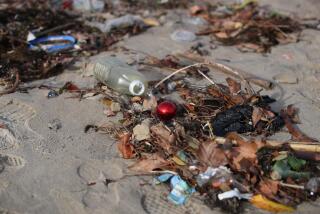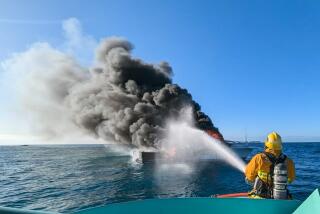A cache of family memories on Catalina Island
We saw the mounds of dirt, covered with rocks and some marked only by simple wooden crosses. Yet the messages they carried were often poignant. Here lay true and loyal friends.
“We’ll miss you”
“M&M, the M-ster”
“Rock Star”
“Fredie Fish: He drowned.”
We had stumbled upon a resting place for man’s best friends. We pushed along the dusty trail, eyes darting, searching. It was quiet in this cool, dappled alcove, and we were alone
just the seven of us.
Sean, 15, with his bloodhound nose and Sherlock Holmes instincts (and a nifty GPS device), pointed the way through the trees. Matt spotted it first, overturned the bricks and said, as offhandedly as only a 13-year-old could: “Found it.” As Holly, 16, and Nick, 14, inventoried the loot, Ellen, 3, said: “Carry me. Somebody carry me.”
That’s what I wanted too. But long, sweaty geocache hikes and camping were the point of this early July weekender to sunny Avalon, where neither heat nor crowds could dim Catalina Island’s lapis lazuli beauty.
Newbies to the island, we wanted to remain within walking distance of the main drag and get to know Avalon. For seven people on a budget, that meant staying at the only Catalina Island campground that’s within the city’s 2 square miles: Hermit Gulch.
It’s a bit more civilized than Catalina’s four other campgrounds, which include -- at the opposite end of the spectrum and the opposite end of the 21-mile island -- isolated Parson’s Landing, a hike-in primitive site with no fresh water.
Hermit Gulch, on the contrary, is “close to Avalon, with hot showers and flush toilets, a microwave, vending machines, shuttle,” said amiable ranger Waylon Graham.
Another perk: Graham lives on-site. That does provide some peace of mind, but it didn’t solve our Night No. 1 problem.
But first, Day No. 1. We arrived aboard the Catalina Express, which we caught in San Pedro, with our daunting pile of gear. Hermit Gulch is about a mile and a half from downtown, a slight uphill hike all the way. A taxi ferried our stuff, and us, to the campground (less expensive than having our things transported and walking there and less heinous than the idea of carrying it all up ourselves). After setting up a trio of tents and discovering, to my extreme dismay, that the battery-powered pump I’d brought for my air mattress had had a meltdown on the trip over, we took off for town on foot along Avalon Canyon Road.
We passed a softball field, a golf course that often had as many deer as golfers, a clean, new playground that the tot loved, plus “Keep Out” signs where blackened earth showed that the May fires had burned close to downtown.
Near the boat landing and the sandy little beach, visitors filled the waffle shop, the pizza place where peanut shells littered the floor, the ice cream and fudge shops. They wandered the mini-golf course, cool in its deep shade, and buzzed around in their rent-by-the-hour golf carts like bees in a honeyed hive. It was fun as we meandered the streets to try to spot the tiniest vehicles and narrowest spaces between the vacation houses that were squeezed together downtown. We also spotted, in two days, three couples decked out in wedding finery. There’s much to enjoy about touristy Avalon, but our geocache (pronounced geo-cash) hunts took us tramping off the main drag.
According to Geocaching.com, the basic idea of the activity “is to have individuals and organizations set up caches all over the world and share the locations of these caches on the Internet. GPS users can then use the location coordinates to find the caches. Once found, a cache may provide the visitor with a wide variety of rewards.” Note: The “rewards” found on various hunts thus far have included a giant fake coin, a yo-yo and a plastic penguin named Penny.
Penny was attached to a “travel bug,” a medallion that resembles a dog tag and contains a tracking number that allows its original owner to follow its travels from cache to cache over the Internet. Geocachers are supposed to deposit the bug at another cache within two weeks. (To keep it longer is impolite.) Penny originally came from Newport, R.I., and has traveled as far as South Africa. We left Penny at the pet cemetery. But she didn’t rest in peace for long. She was picked up the following day.
“All the visitor is asked to do,” the site continues, “is if they get something they should try to leave something for the cache.” OK, so the stuff we left wasn’t that thrilling, either.
But for us, the point of the activity was to get our teenagers outdoors, stretching their legs along roads and trails, sniffing the air and appreciating Catalina views. Having a goal made the hikes more fun.
A cache is usually a plastic container with assorted objects and a log sheet where finders sign in; caches come in different sizes, from plastic tubes containing only a log to large tubs. But even the big ones may not be that easy to find. Our hunters found five out of the seven caches they had sought.
During one humiliating attempt, they beat through bushes for about 30 minutes in search of a find when a young non-geocaching passerby -- known as a “muggle,” thanks no doubt to geocaching Harry Potter fans -- casually pointed it out. Gee. Thanks.
After our long walk and a big dinner downtown, it was nice to hop on the Avalon Trolley and be hauled up the hill to Hermit Gulch.
The campground’s busy and not always quiet. On our first night there, we found that we’d picked a poor spot to set up camp. (The sites are not assigned.) We were awakened when a group returned late to the campground in a convivial mood. If you don’t like late-night conviviality that doesn’t involve you, don’t park your tent adjacent to the “group” site. Despite colorful shouting from other tents and a visit from a ranger, the revelry never really stopped for this happy bunch.
The next day, they left, and our group took off hiking again. My husband and I sampled a winding trail that began at the campground and quickly headed upward, providing views of hills and distant white boats dotting the blue sea. By that night, our group had an impressive two-day tally: 30 miles hiked, four trips to Cold Stone Creamery and way too many missed showers. We’d also moved to the opposite side of the campground.
A roomy tent cabin added $45 to the bill, but it was near hills and quiet neighbors, and the slightly creaky cots inside were so much more comfortable than the ground.
Sweet relief.
More to Read
Sign up for The Wild
We’ll help you find the best places to hike, bike and run, as well as the perfect silent spots for meditation and yoga.
You may occasionally receive promotional content from the Los Angeles Times.







